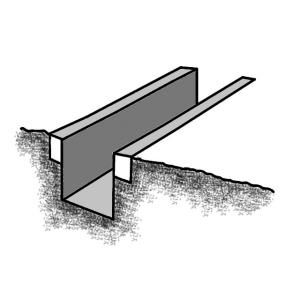Resumen ejecutivo
A storm water system with open channels for the discharge of rainwater exists in most urbanised areas. The channels usually drain off rainwater into rivers or sometimes into agricultural irrigation canals. Unauthorised discharge of domestic wastewater into the system leads to surface water pollution and spreading of pathogens. Solid waste is also commonly disposed of in these open channels. This is particularly a problem in many middle- to low-income countries. To avoid blockages and unauthorised discharge of litter or wastewater, open drains can be covered by concrete slabs. However, where no wastewater infrastructure exists, drainage of waste and greywater into such a system could be a temporary solution. Before discharging waste- or greywater into open drains, appropriate settling and possibly treatment of wastewater should be considered (e.g. septic tanks, biogas settlers, constructed wetland or waste stabilisation ponds).
| Entradas | Salidas |
|---|---|
Precipitation, Greywater |
Introduction
The most basic way to drain off rain and stormwater is via open channels. A more developed but also more expensive solution is a separate sewer system. Separately collected stormwater has high potential for increasing agricultural production in rural areas. In addition a more integrated approach to water management in urban areas can be achieved by replenishing freshwater resources after a natural pre-treatment of the collected stormwater (e.g. free-surface constructed wetlands) and a recharge of surface or groundwater bodies (see also stormwater management). In both cases the receiving water bodies may be sea, lake, river or groundwater (also see surface disposal of liquids, surface groundwater recharge, subsurface groundwater recharge).
Basic design principles
An open channel or drain system generally consists of a secondary drainage system, with a network of small drains attached (micro-drainage). Each serves a small catchment area that ranges from a single property to several blocks of houses (WHO 1991). These small drains bring the water to a primary drainage system, composed of main drains (also called interceptor drains), which serve large areas of the city. Thereafter these drains are generally connected with natural drainage channels such as rivers or streams (WHO 1991).
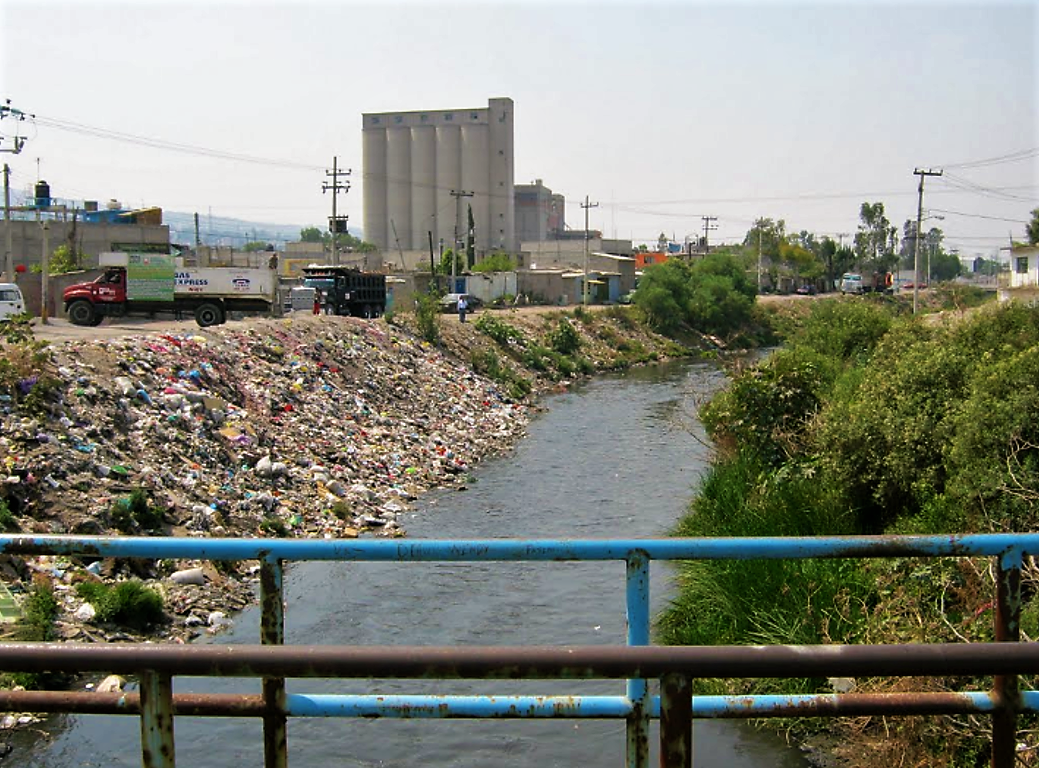
Not all water precipitating as rain needs to be removed by the drainage system. Some will direct absorption by naturally infiltrating into the ground, while some may stand in puddles and other depressions and eventually evaporate. The part that drains off the ground surface (runoff) into the drainage system is known as the runoff coefficient. There is little chance for evaporation during a rainstorm, so that the runoff coefficient used to calculate the size of the drains required should be based on the infiltration capacity of the ground. The latter mainly depends on soil condition (if the drainage system is not lined, as is often the case in rural areas, chances of percolation are high); the slope of the terrain (steep slope or flat area); land use in the catchment area (roofs and pavement prevent infiltration) and the intensity of rainfall (e.g. design for a 5-year storm return period).
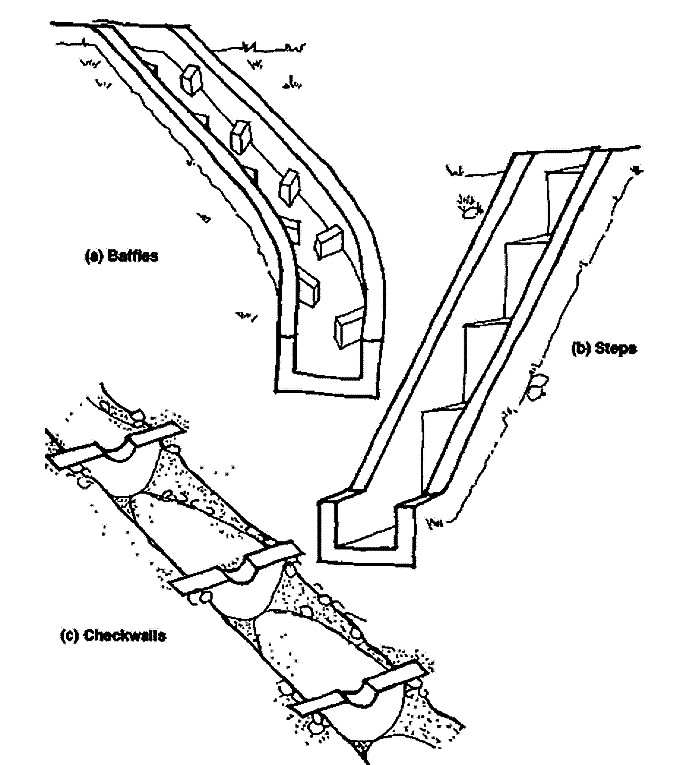
A return period of five years is widely used to design primary drainage systems in tropical cities, but shorter periods (three years or less) are more suitable for micro-drainage within residential areas, where an occasional overflow is less likely to cause serious damage. If it is designed too big, it may never be fully amortised within its lifetime. In this case the money for the big construction could have been used for other constructions (e.g. micro-drainage in areas without any canals).
On steep terrain, erosion could damage the drain. It is therefore important to prevent water from flooding down in uncontrolled flows that may wash out houses and turn passages such as pathways and streets into an impassable gulleys. As a rule of thumb, slopes of more than 5% can be considered steep slopes. There are several types of constructions that impede the water flow (WHO 1991).
In flat low-lying areas subject to flooding, a major problem often results from the relatively high level of the receiving water body. Because of the limited slope to which drains can be laid when water flows along them it is quite slow and inefficient. Together with the difficulty of digging deep drainage channels especially where the groundwater level is high, results in drains having to be proportionally wider in order to have sufficient water passage. There is also a risk of puddle building in which pests such as mosquitoes can breed. Building a drainage channel with sloping sides and a narrow bottom helps to maintain a steady flow speed whatever the water level in the channel. A refinement of this principle is to build a channel with a composite section (see picture below) (WHO 1991).
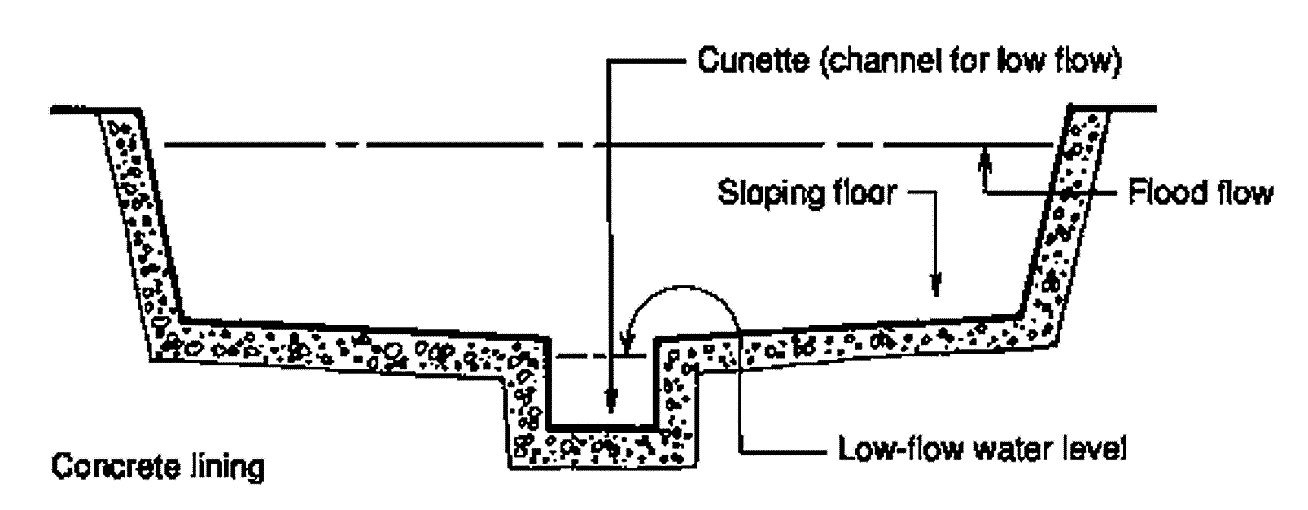
Transportation of wastewater in open drains
As mentioned in the executive summary, it could be a temporary solution to transport wastewater (greywater or even blackwater) in open drainage systems.Open drains are not a satisfactory technology for transporting sewage, even when the solids have been removed by some form of septic/interceptor tank (even sullage is likely to carry faecal contamination from laundry wastes, hand and body washing etc., albeit the concentrations being lower this should be considered). There are two reasons why open drains are unsatisfactory for sewage transport (CORCORAN et al. 2010):
- People can easily come into contact with the wastewater, with its potentially high pathogen content.
- Since it is almost impossible to keep stormwater out of drains, any flooding will be floodwater merged with diluted sewage (WORLDBANK 2011). Very often open drains/channels are misused for depositing litter, excreta and household sewer lines are sometimes illegally connected to open drainage systems.
Cost considerations
Compared to underground sewer systems (e.g. conventional sewer or separate sewer) open drains are a less expensive solution. The precise cost depends on local conditions. If terrain is very step, extra construction has to be fabricated to slow down the velocity. Also very flat areas could raise the budgeted cost (deep, or where groundwater table is high, wide excavation). Consideration of community participation could have a positive offset on the overall costs. For example voluntary labour can permit significant savings in cost, which can be an important consideration for most municipalities in developing countries, due to very limited availability of funds to invest in infrastructure. A typical value for the annual cost of maintenance would be about 8% of the construction cost of the system (WHO 1991).
Operation and maintenance
Keeping drains free of refuse poses a problematical obstical. Unfortunately it is commonly believed that a drain is a convenient place for depositing solid waste, wastewater, greywater and even faecal sludge, especially where there is no adequate refuse or wastewater collection service (see also water pollution). Refuse and faecal matter in drains quickly becomes malodorous as it decomposes and poses as a suitable medium for flies and mosquitoes for egg-laying and as a hospitable site for many pathogenic bacteria and viruses. Removal of such material from the drains is not a popular task (WHO 1992), but crucial for protecting the public health (see also health and hygiene issues).
The main duties and responsibilities for operation and maintenance of an open channel drainage system are (WHO 1991):
- Routine drain cleaning
- Reporting of defects and blockages
- Semiannual inspection
- Repairs
- Payment for maintenance
- Passing of by-laws regarding the use of drains
- Enforcement of by-laws.
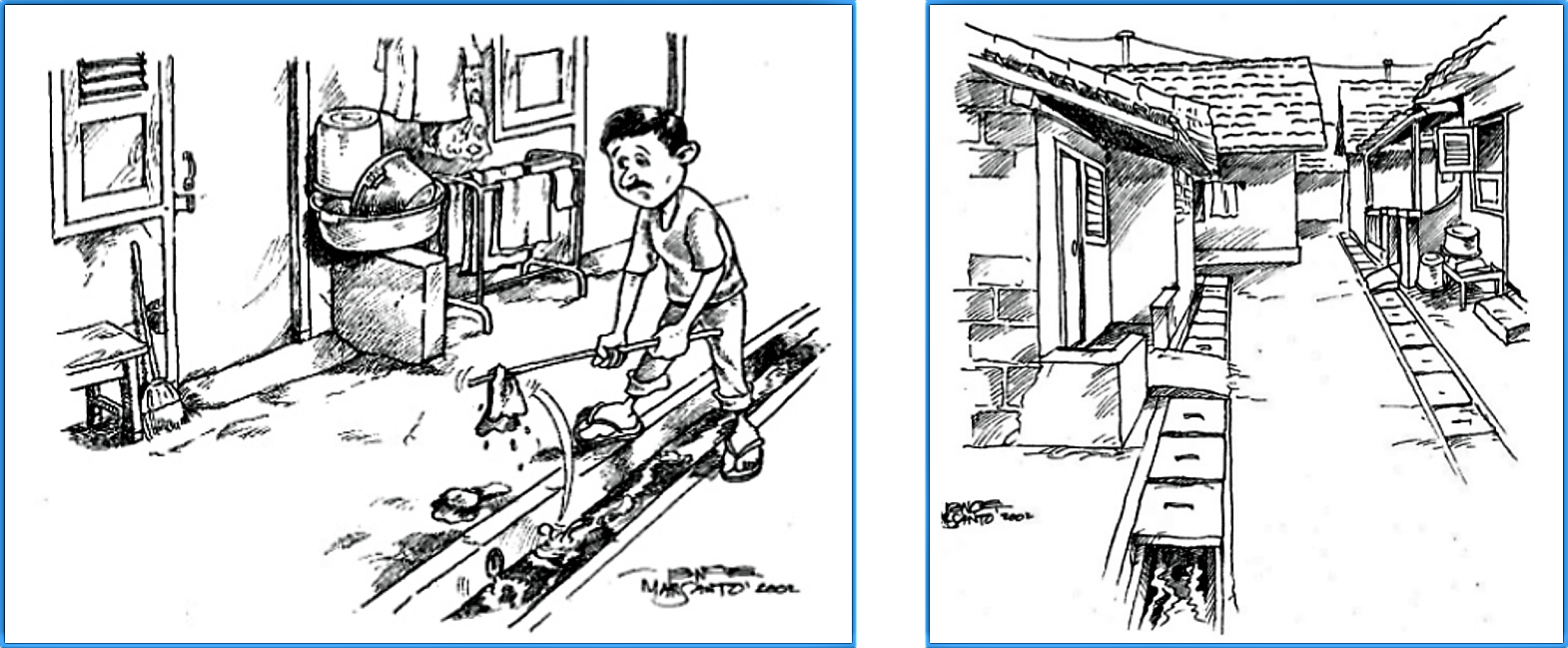
However, the most important issues to optimise existing open drain systems are: preventing overflow (see operation and maintenance above) and waste entering the system. To prevent faecal matter and solid waste from entering the system is to cover the drains and provide adequate wastewater treatment and collection systems as well as solid waste management.
Health aspects
Open drain bear a high health risk because they are very often used illegally for the discharge of domestic and/ or industrial wastewater, and solid waste. Moreover, ponding water forming pools encourage mosquito breeding, and children have a tendency to play in them. Ponding is likely to occur where: the terrain is flat and the drain slope small, where the drains are rough and unlined so that water collects in depressions, where solid waste is deposited in the drains leading to a clogging effect and where drains are filled to allow vehicles or pedestrians to cross (WHO 1992). This is a high risk for the public health (see also waterborne diseases - pathogens and contaminants). Also defecation into those drains is not an unusual habit and needs to be circumvented by the community.
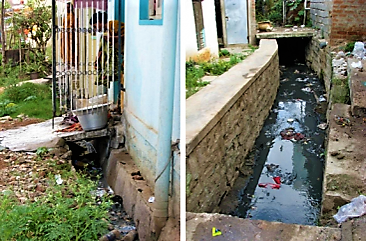
At a glance
| Working principle | The open drains collect storm and sometimes sewage, then drain it off into rivers, lakes or agricultural irrigation canals. |
| Capacity/adequacy | To be found in smaller and larger urban as well as rural areas, in coastal areas often influenced by tide level of sea. Furthermore they are prone to flooding or clogging in rainy season. |
| Performance | Good performance if designed correctly and kept free from solid waste. |
| Costs | Still cheaper than advanced sewer systems, but terrain, labour and material could raise the investment costs. |
| Self-help compatibility | High |
| O&M | Open drains are easy to maintain but must be well organised. |
| Reliability | Open drains are prone to blockage caused by garbage and solids. |
| Main strength | Simple to construct with locally available materials |
| Main weakness | It is prone to be used as a disposal for all kinds of waste and can cause health risks for residents. |
Open drains are easy to construct and if there are existing drains it is a low-cost solution. It can be constructed in almost all types of settlements (urban or rural), but enough land area is required to build a reasonable construction. To prevent clogging scheduled maintenance is necessary.If a new drainage system is planned, the community should be involved to solve problems of land requirement and workforce before the construction start to avoid conflicts and create productive employment.
Even though open drainage systems offer very simple solutions for stormwater conduction they bear many risks for public health and the environment due to the risk of illegal discharge of wastewater and solid waste. Therefore, if possible, they should be applied only where an adequate wastewater treatment and collection system is in place and a solid waste management is provided.
Sick Water? The central role of wastewater management in sustainable development
This book not only identifies the threats to human and ecological health that water pollution has and highlights the consequences of inaction, but also presents opportunities, where appropriate policy and management responses over the short and longer term can trigger employment, support livelihoods, boost public and ecosystem health and contribute to more intelligent water management.
CORCORAN, E. ; NELLEMANN, C. ; BAKER, E. ; BOS, R. ; OSBORN, D. ; SAVELLI, H. (2010): Sick Water? The central role of wastewater management in sustainable development. A Rapid Response Assessment. United Nations Environment Programme (UNEP), UN-HABITAT, GRID-Arendal URL [Visita: 05.05.2010] PDFInformed Choice Catalogue
This informed choice catalogue for community based wastewater treatment technologies helps to identify suitable sanitation options and facilitates the assessment of different sanitation system components with regard to stakeholder preferences. A powerful tool for technical bottom-up planning giving overall information about technical options at a "glance".
SANIMAS (2005): Informed Choice Catalogue. pdf presentation. BORDA and USAID URL [Visita: 29.05.2019]Prohibido tirar basura - El Gran Canal
A Guide to the Development of On-site Sanitation
The publication presents appropriate technologies for sanitation and highlights socio-economic aspects of planning and implementing. Emphasis is given to household-level sanitation improvements for urban areas, as well as rural areas and small communities. Background information on sanitation, in-depth technical information on the design, construction, operation and maintenance and project planning and development processes involved in projects and programmes complement the book.
WHO (1992): A Guide to the Development of On-site Sanitation. Geneva: World Health Organisation (WHO) URL [Visita: 14.04.2010]Surface Water Drainage for Low-Income Communities
This document describes the surface water drainage very exactly and includes design calculations, health hazards, costs and maintenance.
WHO (1991): Surface Water Drainage for Low-Income Communities. Geneva: World Health Organisation (WHO) URL [Visita: 21.09.2011]Wastewater Disposal and Transport Options – Open Drains
Sick Water? The central role of wastewater management in sustainable development
This book not only identifies the threats to human and ecological health that water pollution has and highlights the consequences of inaction, but also presents opportunities, where appropriate policy and management responses over the short and longer term can trigger employment, support livelihoods, boost public and ecosystem health and contribute to more intelligent water management.
CORCORAN, E. ; NELLEMANN, C. ; BAKER, E. ; BOS, R. ; OSBORN, D. ; SAVELLI, H. (2010): Sick Water? The central role of wastewater management in sustainable development. A Rapid Response Assessment. United Nations Environment Programme (UNEP), UN-HABITAT, GRID-Arendal URL [Visita: 05.05.2010] PDFInformed Choice Catalogue
This informed choice catalogue for community based wastewater treatment technologies helps to identify suitable sanitation options and facilitates the assessment of different sanitation system components with regard to stakeholder preferences. A powerful tool for technical bottom-up planning giving overall information about technical options at a "glance".
SANIMAS (2005): Informed Choice Catalogue. pdf presentation. BORDA and USAID URL [Visita: 29.05.2019]A Guide to the Development of On-site Sanitation
The publication presents appropriate technologies for sanitation and highlights socio-economic aspects of planning and implementing. Emphasis is given to household-level sanitation improvements for urban areas, as well as rural areas and small communities. Background information on sanitation, in-depth technical information on the design, construction, operation and maintenance and project planning and development processes involved in projects and programmes complement the book.
WHO (1992): A Guide to the Development of On-site Sanitation. Geneva: World Health Organisation (WHO) URL [Visita: 14.04.2010]Surface Water Drainage for Low-Income Communities
This document describes the surface water drainage very exactly and includes design calculations, health hazards, costs and maintenance.
WHO (1991): Surface Water Drainage for Low-Income Communities. Geneva: World Health Organisation (WHO) URL [Visita: 21.09.2011]The Impact of Densification by Means of Informal Shacks in the Backyards of Low-Cost Houses on the Environment and Service Delivery in Cape Town, South Africa
This paper investigates the state-sponsored low cost housing provided to previously disadvantaged communities in the City of Cape Town, South Africa. The design of state-subsidised houses and the construction of unplanned housing in the backyard added enormous pressure on the existing municipal infrastructure and the environment. Municipal water, sewerage systems and solid waste disposal cannot cope with the increased population density combined with the poor sanitation behaviour of the inhabitants of these settlements. The low-cost housing program in South Africa requires improved management and prudent policies to cope with the densification of state-funded low-cost housing settlements.
GOVENDER, T. BARNES, J.M. PIEPER, C.H. (2011): The Impact of Densification by Means of Informal Shacks in the Backyards of Low-Cost Houses on the Environment and Service Delivery in Cape Town, South Africa. Auckland: Libertas Academica URL [Visita: 29.05.2019]Kiambiu Water and Sanitation (KIWESA) slum project, Nairobi, Kenya
This short presentation describes problems and solutions in waste management and sanitation in the Kiambiu Slum.
KAIRU, E. (n.y): Kiambiu Water and Sanitation (KIWESA) slum project, Nairobi, Kenya. Nairobi: Maji na Ufanisi URL [Visita: 09.06.2011]Rural Water Supply and Sanitation Challenges in Latin America for the Next Decade
Based on market research, this new WSP technical paper analyses the main features of the fecal sludge collection businesses in each city, including the marketing mix, potential demand, supply capacity, and legal frameworks. In addition, the paper spotlights major challenges and opportunities in fecal sludge management, describing the current and potential market for fecal sludge removal, collection, and disposal in peri-urban areas—which typically struggle with high population density, limited land planning, high citizen insecurity, and low coverage of basic services.
PEARCE-OROZ, G. (2011): Rural Water Supply and Sanitation Challenges in Latin America for the Next Decade. Lima: Water and Sanitation Program (WSP) URL [Visita: 14.05.2012]Beyond Scarcity: Power, Poverty and the Global Water Crisis
This short YouTube movie explains the water and waste problem in poor and densely populated areas (in this case Kibera, Nairobi).

